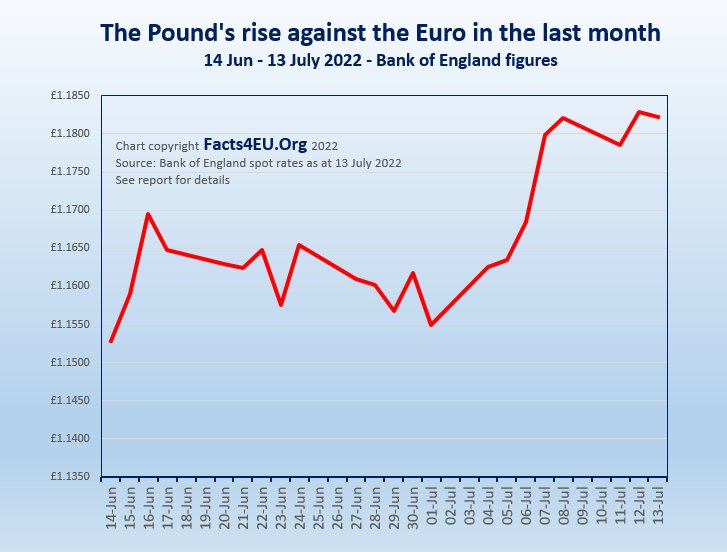Brexit Britain’s economy shoots forward again and the pound rises
This report has been co-published with our affiliated organisation, Brexit Facts4EU.Org. We are most grateful for their original research into the raw data which backs what follows.
Meanwhile, the Eurozone currency is in freefall as the EU’s crises deepen
Euro falls to near parity with US Dollar – worst for 20 years
This is a tale of two economic zones: the newly independent United Kingdom and the European Union. Good news in one (the UK) and bad news in the other (the EU).
Summary
UK and EU economies compared
- UK’s economic output (GDP) : +0.5% in May
- GDP growth over last 12 months: +3.5%
- UK economy now well above pre-pandemic levels
- EU economy still well below pre-Covid levels
- Pound rises against the euro
- Euro falls against the US dollar
[Sources: Latest data from ONS, EU Commission, BoE, and ECB.]
 Currencies – the pound versus the euro
Currencies – the pound versus the euro
When it comes the pound’s value against the euro, things have not been going well for the Eurozone recently. To the left are the official numbers from the Bank of England for the last month.
© Brexit Facts4EU.Org 2022 – click to enlarge
[Source : Bank of England Database, Spot exchange rate, Euro into Sterling, 13 July 2022.]
Brexit Britain continues to grow
According to the Office of National Statistics in its latest report published yesterday (13 Jul 2022), UK GDP rose by 0.5% in May, beating all analysts’ predictions. UK growth in the 12 months to May 2022 was a very healthy 3.5%.
GDP rose in all three key areas: in services, in manufacturing, and in construction. Not only that, but the slight fall in April has been corrected as it had been overstated.
In contrast to various negative comments from the ‘doom-and-gloom’ commentators about UK manufacturing, the ONS say “Manufacturing increased by 1.4% in May 2022 with twelve of the thirteen sub-sectors rising on the month.”
How is the UK doing compared to the EU?
According to the UK’s Office for National Statistics on 13 July 2022:
“Monthly GDP is now estimated to be 1.7% above its pre-coronavirus (COVID-19) pandemic levels”
However, according to the EU’s official statistics agency Eurostat on 29 June 2022:
“[EU] GDP remains 0.8% below the 2019 pre-COVID level”
It is also worth mentioning that without the very large reduction in spending on ‘NHS Test and Trace’, the ONS says that the UK’s growth in May would have been even higher, at 0.7%.
Currencies – the falling euro
One of the measures whereby financial markets give their verdicts on the economic performance of countries is by the value of their currencies.
As we reported on Wednesday last week (05 July 2022), the euro has been under increasing pressure for the past year. In the last five months of this year alone it had fallen by 10.1%. Since then the position has got even worse.
The official rate from the European Central Bank yesterday (13 July 2022) had almost dropped to parity against the US dollar, standing at €1 = $1.0067. In January the euro bought $1.1355 US dollars.
Germany’s woes continue
Yesterday Russia’s Gazprom announced that they could not guarantee the resumption of gas supplies to Germany after the current maintenance period for the Nordstream I pipeline supposedly ends on 21 July 2022.
This could have some serious implications for Germany’s all-important industrial sector.
The only consolation is for Germany’s exporters, whose products are now comparatively cheaper in the US market as a result of the fall in value of the euro. In its latest official figures Germany’s exports actually fell for the first time in 30 years, so this might give some succour to Chancellor Scholz.
For the original article, click here: https://facts4eu.org/news/2022_jul_sun_shines_on_uk